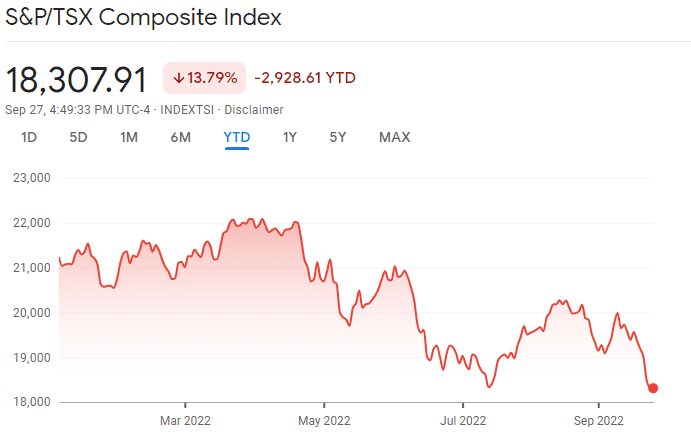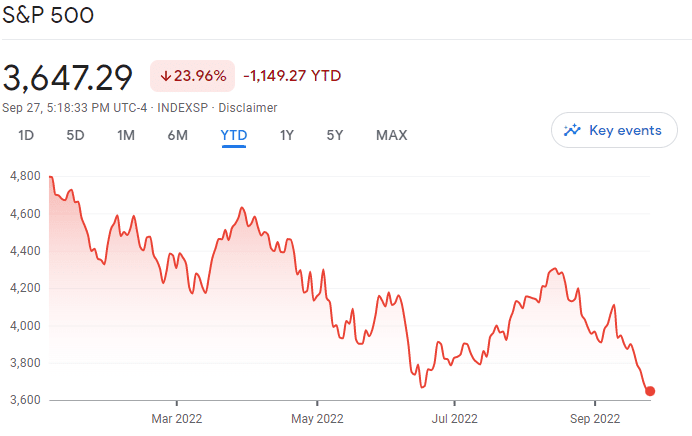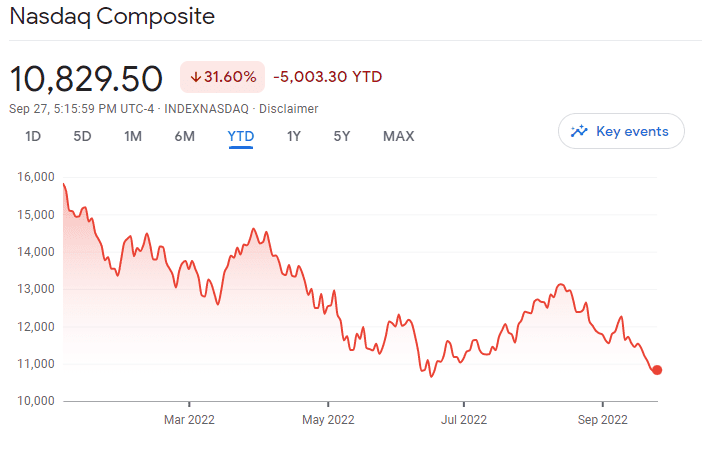Unless you’ve been living under a rock, you probably have heard that the global stock market has been on a downward spiral. Yup, the bear has entered the room and many of us are seeing beet red market conditions over the last number of months.
Year to date the TSX is down more than 13%.

Meanwhile, the S&P 500 is down more than 22% year to date.

The typically high-flying NASDAQ is down more than 30% year to date.

For those investors that only started investing in 2021 or those that are used to the only-going-up-bull-market condition, the recent downward trend is undoubtedly hard to stomach.
Given that we’ve been DIY investing for more than a decade, some readers have reached out and asked what we’re doing in this bear, beet red market condition.
So what are we doing?
Allow me to explain.
Think long term
First of all, it’s essential to think long term. If you’re still in the accumulation phase, like us, you should be wishing and hoping for an extended bear market.
Why?
Because investors in the accumulation phase will want to buy stocks at discounted prices.
How often do you see the likes of Royal Bank and TD having an initial dividend yield of over 4.1%? The 10-year historical average dividend yield for Royal Bank is 3.92% while the 10-year historical average dividend yield for TD is 3.8%.
Let’s not forget that TD has been paying uninterrupted dividends since 1857 and Royal Bank has been paying uninterrupted dividends since 1870.
If the share price continues to drop, the starting dividend yield will continue to go up. It’s unfathomable to see Bank of Nova Scotia and CIBC having dividend yields of over 6% and 5.5% respectively. In case you’re curious, BNS’s 10-year historical average dividend yield is 4.4% and CIBC’s 10-year historical dividend yield is 4.8%.
Furthermore, many blue-chip Canadian dividend stocks have been taking a beating lately and are entering price points that are quite attractive in terms of overall valuation and future growth. If the market stays flat for a while or continues to go down and you buy more shares now, in a few years when the market recovers, I think you will be quite pleased.
Imagine purchasing Royal Bank during the financial crisis when the sky appeared to be falling. If you were convinced back then that Royal Bank was a bargain at around $30 in 2009 and the company would continue to make billions in net income each quarter, and it would continue to pay uninterrupted dividends for the foreseeable future, buying Royal Bank back then made a lot of sense just as long as you had a long term view.
If you had done so and bought Royal Bank at around $30, you’d be looking at a hefty profit! Not to mention all the dividends you’d have collected over the years.
Yes, the sky seems to be falling again due to the ever rising interest rates and people are worried that we’d face similar stock market stagnation like Japan.
For now, I’m putting my trust in the Fed and the Bank of Canada. I believe they have learned from what Japan did in the past and won’t make the same mistakes. Therefore, I’m not as worried about potential stagnation. Instead, I think the current bear market will continue for maybe another six months or a year and the market will eventually recover.
But as I said, I’m secretly hoping the bear condition will last for a while so we can continue to buy stocks at discounted prices.
Buying regularly – dollar cost average
Another key action we’re doing is buying regularly. In the last number of years, we’ve been saving money every pay cheque and using the saving to purchase dividend-paying stocks and index ETFs every month. Some months the amount is higher and some months the amount is lower, but the important thing is that we’re investing regularly.
By buying dividend paying stocks and index ETFs regularly, we are taking advantage of dollar cost averaging.
In addition, we enroll in DRIP whenever we’re eligible. By dripping either quarterly or monthly, we are adding more shares and taking advantage of dollar cost averaging as well.
The beauty of the dollar cost average is that if the market is down, we’d buy at a lower price, and possibly more shares in our DRIPs too; if the market happens to be up, we’d buy fewer shares.
In case you’re curious, below is what we’ve purchased so far in 2022.
| Ticker | Shares | Month Purchase | Accounts |
| SRU.UN | 203 | Jan | TFSA |
| GRT.UN | 64 | Jan | TFSA |
| ENB.TO | 320 | Jan | Reg |
| AQN.TO | 387 | Jan | RRSP |
| BEPC.TO | 26 | Jan | RRSP |
| AAPL | 16 | Feb | RRSP |
| CM.TO | 32 | Feb | RRSP |
| BCE.TO | 58 | Mar | Reg |
| POW.TO | 157 | Mar | TFSA |
| BMO.TO | 61 | Mar | Reg |
| AAPL | 7 | Mar | RRSP |
| SBUX | 10 | Mar | RRSP |
| BMO.TO | 15 | Apr | Reg |
| BMO.TO | 11 | Apr | Reg |
| BNS.TO | 25 | May | Reg |
| BCE.TO | 28 | May | Reg |
| BCE.TO | 33 | May | Reg |
| COST | 2 | May | RRSP |
| CM.TO | 56 | May | Reg |
| AAPL | 11 | May | RRSP |
| XAW | 111 | Jun | Reg |
| MFC | 105 | Jun | Reg |
| MFC | 193 | Jul | Reg |
| BLK | 4 | Jul | RRSP |
| BMO.TO | 40 | Aug | Reg |
| BCE.TO | 102 | Aug | Reg |
| BCE.TO | 104 | Aug | TFSA |
| BMO.TO | 9 | Aug | TFSA |
| CM.TO | 32 | Sep | Reg |
Yes, we have deployed a lot of dry powder in the past year. Yes, we’re in beet-red territory, seeing a paper loss of over 11% at the time of writing. But if we continue buying every month and dollar cost average, I truly believe we’ll be OK in the long run.
Keeping it simple
I believe the biggest mistake that many investors make is using complicated investing strategies, like swing trades, channel breaking, seasonality, Fibonacci sequence, etc. Your portfolio is like a bar of soap, the more you touch it, the smaller it gets. So by using complicated investing strategies, more often than not, you’re hurting yourself.
I certainly have made the same mistake in the past.
Nowadays I believe in keeping it simple – I want to be an owner, I want to own companies that make products that I rely on on a daily basis, and the more reliant I’m on the products the better.
Furthermore, it is important to stay curious and learn about companies that you own or may be interested in.
If you invest in a highly profitable company that provides unique services or makes unique products and has a wide moat, there’s no reason why the company can’t continue to make millions in profit.
Dear readers, what are you doing in this bear beet red market condition? Are you doing something different than us?


I am a retiree, have the defined benefit plan, registered accounts, including RRIF, TFSA and taxable account. I am required to withdraw a prescribed amount every year for the RRIF a/c. I am divided as to what stocks, ETF’s to withdraw every year. Should I sell my winning stocks or sell my winning ETF’s? Any strategy as to what to withdraw so that I can keep getting a profitable return on my investments? I am heavily weighted in oil & gas stocks, like Freehold Royalties (FRU) that pays a hefty monthly dividend of around 6%, Tourmaline (TOU), Canadian Natural Resources (CNQ), Cenovus (CVE), etc. As you can see, they are all blue chip stocks. I am having quite a dilemma as which stocks I should pick to sell?? I have several “dog stocks” too, including speculative stocks that have done poorly, but have the potential to reward me handsomely in the future. Should I sell those speculative stocks or the blue chip ones?? Any suggestions would be greatly appreciated.
Hi Ken,
That’s a very good question. It really depends if the speculative stocks will recover or not. My suggestion would be selling a mix of the blue chip and the speculative stocks… maybe 50-50 or some sort of mix. Personally if I were you I’d start trimming these speculative stocks.
1. Are you still buying XAW for your children’s RESP, or are you thinking of purchasing another ETF?
2. Do you have a post about the advantages or disadvantages of a family RESP vs individual child’s?
Hi Dennis,
We buy XEQT in our kids’ RESP. XAW is used for our dividend portfolio for geographical diversification.
Sorry, don’t have a post on family RESP vs individual RESP. Perhaps a future post idea.
Thanks for the reply and thanks for blogging. Reading your post has helped me make better decisions in my investing.
A good article, Bob, with lots of useful detail, your buying list in particular. I am 82, and have been retired for over 25 years. While I have been investing since the start of my retirement, beginning with a severance package, I was misled by a “financial adviser” and stumbled along for perhaps 15 years, losing money all the way. The first good move was to become self-directed. The second, coming late to the party, was to realize the value of dividend investing, thanks to several good bloggers.
It is quite apparent, even in the above correspondence, that retirees fall into two groups, those with a defined benefit pension and those without. The former, including myself, are in a much, much more comfortable position, and can view their pension as fixed income (often indexed). This leaves the prospect of having 100% of their investment portfolio in equities. And having them largely or wholly in dividend growth stocks follows the same philosophy that got the investor into “a good steady job” in the first place. Those without this financial backbone (i.e. the dfb pension) have a much more difficult job, and if they have not invested sensibly for many years they have a tough time ahead.
As an immigrant, I did what many did, I “followed the money” and spent most of my working life in Canada. Unfortunately, once in Canada, following the money usually takes you into a congested city with high costs of living. And the next generation wants the same. One option to address this is to move into a region, even a province, where this is not so. It is still possible to find a livable home in a nice rural community in eastern parts of Canada, for less than $100,000. But it is not easy to leave family and friends in order to do so. As an immigrant I know that.
Hi Doug,
Thank you. There’s a lot of psychology stuff involved when it comes to investing and for most people, I think receiving dividends does prevent them from selling their investments in a down market. 🙂
Hi Tawcan I am retired living off of RRIF income. I always leave cash for about 2 yrs in the account &when market goes up I sell winners to generate cash reserve going forward. If Mr Market is not cooperating I reduce my expenses which improves the time line for my buffer. Its the hand to mouth approach on slow motion.
Thank you for all your posts .
Appreciatively
Michael
Thanks Michael, having a cash wedge and sell winners when the market goes up seems to make sense. Hopefully Susan is sticking around to read more comments. 🙂
I agree Tawcan, I’m hoping the bear market last a little longer to get some cheap positions. Buying Intel at $25? Thats a steal for goodness sake! It’s just simply out of favor, just like so many others. Buy consistently, DRIP, and have a long term time horizon, and this will become a blip on the map in 10 years.
Intel might be a bit of a value trap currently though. They’ve been overtaken by the likes of AMD, Qualcomm, and Apple. Heavy investment and catching up are needed for Intel IMO. I think the stock price will eventually recover, it’ll take some time though.
Great post, Bob. As the kids say “100”. Agree with Alex et al. RE: Retirees, that if you are not selling your positions and just living off dividends this market turbulence should NOT be of concern. Regardless it may make sense to become more conservative with investments and risk exposure once you reach retirement.
Hopefully we see a hike in TFSA contribution room next year to allow for picking up more DGI stocks on the cheap.
Josh
A hike in the TFSA contribution room next year is a given I think. It’s whether it’ll be $6,500 or $7,000.
Hi Bob, Thank you for your generosity in sharing your journey. I am sure I speak for many who read your column. Here’s a dilemma I’m trying to figure out: Most investors are down somewhere between 10-20% at this point. It seems all but certain a recession is on its way which will drag the market down even more. Would it not be prudent to look further down to add to a portfolio (as you are) rather than at this time. Is there an argument to be made that we are nearing the bottom now?
Thank You
Hi Amin,
The thing is, nobody knows when the bottom of the market is. It’s nearly impossible to time the market. Did anyone honestly have an idea that March 22, 2022 was the bottom of the market? Probably unlikely. But if you had invested on the way down and on the way up, you’d be doing pretty well. That’s what we did back then.
Really great advice, Tawcan. I find it easiest to sum it up with: “just keep buying”.
Right now, we’re continuing to load up on VEQT in our taxable account. And plan to make a sizable RRSP contribution sometime later this year or in early 2023. It really is a great time to buy!
Makes a lot of sense to load up on VEQT.
I review my buy list daily and most prices are down to 2020 levels.
Not buying a lot but Couldn’t resist CM but also got GOOG. EU stocks are bargains so couldn’t resist largest auto producer VW and industrial Siemens.
However I take warnings seriously and many CEO’s are publicly warning or recession and Central banks will continue to raise interest rates.
I need to diversify into fixed income and from this month 70% of my dry powder will be allocated to brokerage GIC’s which likely will be over 5% next month.
More and more stocks are looking quite attractive.
Hi Bob,
I agree with your article and actually started investing in early 2021 thinking that it was still a good time since some of the stocks I was interested in were still below pre-COVID levels. Having paid off my mortgage 3 years ago I’m not concerned about stock price depreciation and want the bear market to continue so I can purchase shares of solid dividend companies on sale. The only thing stressful I find is having some of my money locked up in GICs and seeing all these great opportunities. I’ve been averaging down on most my beaten up positions with each pay check. Recently, utilities like Fortis and Algonquin have fallen off a cliff…waiting for Enbridge to go sub $50 before I start adding to it again. I’ve been adding to Scotiabank, PowerCorp, and several others. In summary I look at this as an opportunity of a lifetime!
Nice to see that you agree with me.
I also started investing in 2021. I keep buying more when I can. Even at an Aux stipend! 🙂
Its a very scary market right now based on the economic fundamentals. Inflation has run rampant for too long and too hot and this is very uncertain times with very high risk. In order to bring things back under control Federal banks have to take drastic steps which may lead to significant impact to the market.
Best to stay away and wait and watch how things unfold. This is NOT the market or time to buy!
Have to say I don’t see it that way so we can say we agree to disagree. 🙂
Hi TigerWWF,
I can understand your concerns in the market. Things do look bad. And things are bad, both fundamentals and technicals. But don’t let that scare you away from the best time to buy with funds you have available for investing. If you believe the market is going to implode, that’s one thing. If you think valuations and profits will be down for a long time, that’s a different story. My biggest regret in investing was NOT investing MORE during the financial crisis of 08. That’s where all my biggest gains have come from. I’m sure we will be saying the same thing come 2034
Agreed! I made the mistake of selling Royal Bank during the financial crisis. Never again!
What do say to retirees whose windows of opportunity are shorter rather than long term. I certainly do not have the time horizon that you talk about.
For retirees it’s important to have the right mix of bonds & stocks and rebalance regularly. GICs may be worthwhile to explore too.
This tells me that your column is not giving advice to retirees. Such a curt answer to Sheldon’s question gives him none of the substantive advice that you provide for the younger audience. I admire your work but sadly your column is not for this senior. I will unsubscribe.
Sorry that you feel my comment was off putting. To be honest, to give proper advice to people closer to retirement or retirees, a proper post is needed, not just a short comment. Hence for the short comment.
Furthermore, since we’re not retired yet, I don’t think I’m the best person to give advice on what to do as a retirees. I am, however, working to see if a retiree can give their perspective on what to do in this market.
Hi Tawcan
As you said “retirees it’s important to have the right mix of bonds & stocks and rebalance regularly. GICs may be worthwhile to explore too”.
But many of us have done this, but are bleeding beet red in what we thought was a safe portfolio.
It would great to see if a retiree can give their perspective on what to do in this market, “retirees” are bleeding. Their perspective would be greatly appreciated.
Doug
Unfortunately, everyone is bleeding beet red, us included. I’m working to have a post on what retirees should do in this market condition. Since we aren’t retired yet, I’m asking someone that’s retired to write the post to give more perspective. Stay tuned please.
Hi Sheldon, I am a retiree and a dividend growth investor. Since I only live from my dividends, I don’t really care much about current stock prices.
Since I have excess income in my TFSA, I can buy the bargains currently available. People in the accumulation phase can do the same.
Retirees not into dividend investing usually have a cash wedge (using GICs or other fixed income investments) to cover about two years of expenses and lower their withdrawal rate during market downturns.
For those doing the 4% withdrawal, in addition to have a cash wedge, may want to consider doing smaller withdrawals, like 3.5% or even 3%. Using GIC ladders may be a good idea too.
As a retiree, I do this myself. I keep a year’s worth of expenses in gics and a high interest savings account because I don’t generate enough dividends from my rrif for the annual withdrawal. This way, I don’t have to sell an investment if it is down. I will just take it out “in kind” and still be able to pay my bills.
Are you still optimistic for recovery in the long term for GRT.UN, T, FTS, etc. in spite of the rising rate environment? Are you sticking with them or do you favour other dividend payers at this time? Thank you!
In short, yes. Plan to buy more of them.
We buy good dividend paying stocks regularly and have enrolled in DRIPS wherever possible. We buy Canadian Bank stocks as dividends continue to rise.
I do enjoy reading your emails regularly and looking forward to seeing you at the Canadian Financial Summit
Thank you Manish.
Sorry…new to investing. What dies Reg stand for? Thanks!
*does not dies 😉
Regular account = taxable = non-registered.
Thank you!
Oh! I thought it was Reg for Registered account. 🙂 Thanks for clarifying.
Great post! I am planning on staying the course. Buying stocks at a discount, locking in some nice yields, and supercharging my dividend cashflow! I’m in it for the long-term. 🙂
Thanks, yup staying the course is exactly what we’re doing.